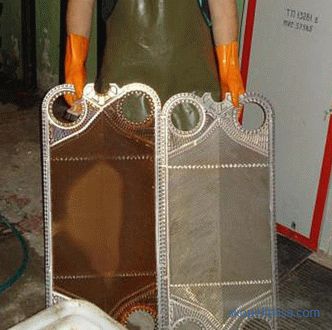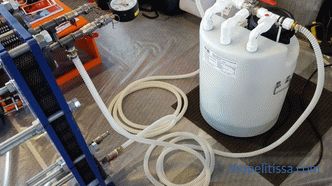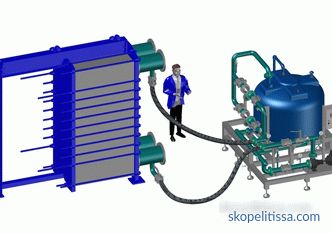A prerequisite for stable and long-lasting operation of the heat exchanger is regular maintenance of the device, cleaning of plates, elastic gaskets, all parts and assemblies from contamination. To do this, use a means for washing heat exchangers. What it is and how it is applied - say the engineers of the company "ProTeplo" www. proteplo. org.
Types of pollution
In most cases, plaque is:
- calcium carbonate;
- fat and organic sediments;
- deposits of iron oxide and salts;
- limestone.
It is formed by the circulation of liquid with impurities that regularly accumulate on the inner walls of the heat exchange equipment. Without flushing, the thickness of the sediment is constantly increasing, impedes the movement of the working medium, interferes with the normal operation of the apparatus and reduces its effectiveness.

Washing of the collapsible plate heat exchanger is possible chemically and mechanically. The first method does not require disassembly of equipment, is more popular. Mechanical cleaning options are used only with a high degree of contamination; they are distinguished by the need to dismantle the heat exchanger and large temporary labor costs.
Selection of means for dry cleaning of heat exchangers
The main rule when selecting a fluid for flushing heat exchangers: the chemical components in the solution should aggressively affect scale, but be neutral with respect to the plates, elastic seals and other parts of the device. This will allow to get rid of pollution and not damage the elements of the device.
Criteria for choosing a means for cleaning a plate heat exchange structure:
- material for the manufacture of plates and gaskets;
- the number and thickness of plaque on the inner walls of the equipment;
- chemical composition of pollution.

looks ready to work To minimize the risk of damage to internal parts of the unit It is recommended to analyze the sediment to determine its chemical composition. This will allow you to choose the most effective and safe means for cleaning the heat exchanger.
Varieties of solutions for flushing heat exchangers
Manufacturers produce means for removing plaque heat exchanger in three versions:
- concentrated liquid;
- powder;
- ready solution.
The first two types require preliminary preparation and dilution with water in the proportion specified by the manufacturer. You can select the washing agent for heat exchangers and boilers here.
Composition of the preparation for flushing the heat exchanger
Modern detergents are distinguished by a variety of chemical composition for the ability to choose the best option for devices of different materials. The concentrate includes:
- organic acids and a complex of reagents - an active substance for descaling;
- acid corrosion inhibitors - a means of preventing damage to the elements of the device and reducing the likelihood of the onset of chemical destruction.
Additionally, antifoaming agents and components can be included in the product to avoid layering.
The cleaning solution formulation provides for the loosening of carbonate pollution and its transfer to a soluble state, as well as the creation of a protective film to prevent metal from corroding. Manufacturers have thought over the color change of the liquid during the washing process to control the process.
Main types of pollution and optimal detergent mixtures:
- Scale deposits and metal deposits effectively destroy phosphoric, citric and nitric acids.
- For iron oxide, experts advise the use of an inhibited high acidity mineral solution, for organic compounds - alkali sodium, mineral contamination - nitric acid.
- Special solvents are offered on the market to combat fatty contamination.
As an alternative, a mixture of sodium carbonate and caustic soda can be used to remove contaminants. It is less harmful to humans, but it does not fight against all types of layers, it is optimally suited for removing biological contaminants, fats and oils.
Self-flushing the gas boiler
The gas boiler can be cleaned at home by yourself. The need for such an event arises when the following symptoms appear:
- constantly working burner;
- uncharacteristic noise from the circulating pump, indicating overload of the system;
- long-term heating of the radiator;
- low hot water pressure in the faucet (for double-circuit gas boilers);
- a significant increase in gas consumption.
At home, the following drugs are suitable for washing the heat exchanger:
- Citric acid is an effective means of dealing with scale when the solution is heated to 60 ° C. It is applicable to heat exchangers made of stainless steel, copper, brass.
- Adipic and sulfamic acids - chemistry for regular washing with a moderate degree of pollution, capable of destroying metal oxides. The concentrate is safe for the heat exchanger of any material.
- Hydrochloric acid quickly copes with a strong precipitate. Suitable for stainless steel and copper equipment. It is worth remembering that most types of metals that are used for the production of plates are not able to withstand its effects. Experts do not recommend using this solution on their own without inhibitors and understanding the chemical processes taking place due to the high probability of damaging the system.
- Orthophosphoric acid is designed to remove dirt and scale. An additional advantage of using is the formation of a protective film. In combination with additional chemical components, the solution allows you to quickly and fully destroy rust-salt deposits and carry out washing in low temperature conditions, with a small concentration of the cleaning mixture.
- Gels that dissolve in water are distinguished by high efficiency and low aggressiveness in relation to the details of heat exchange equipment.
When using the solution, it is necessary to use protective equipment and observe safety precautions.

Conclusion
The main advantage of industrial concentrates is the availability of mixtures of corrosion inhibitors and the calculation by experts of safe proportions of chemical components. Using the correctly chosen washing mixture, the owner will be able not only to carry out effective washing, but also to protect the surface of the heat exchanger plates from the appearance of corrosion, and will prolong the life of the device.
Rate this article, we tried for you




